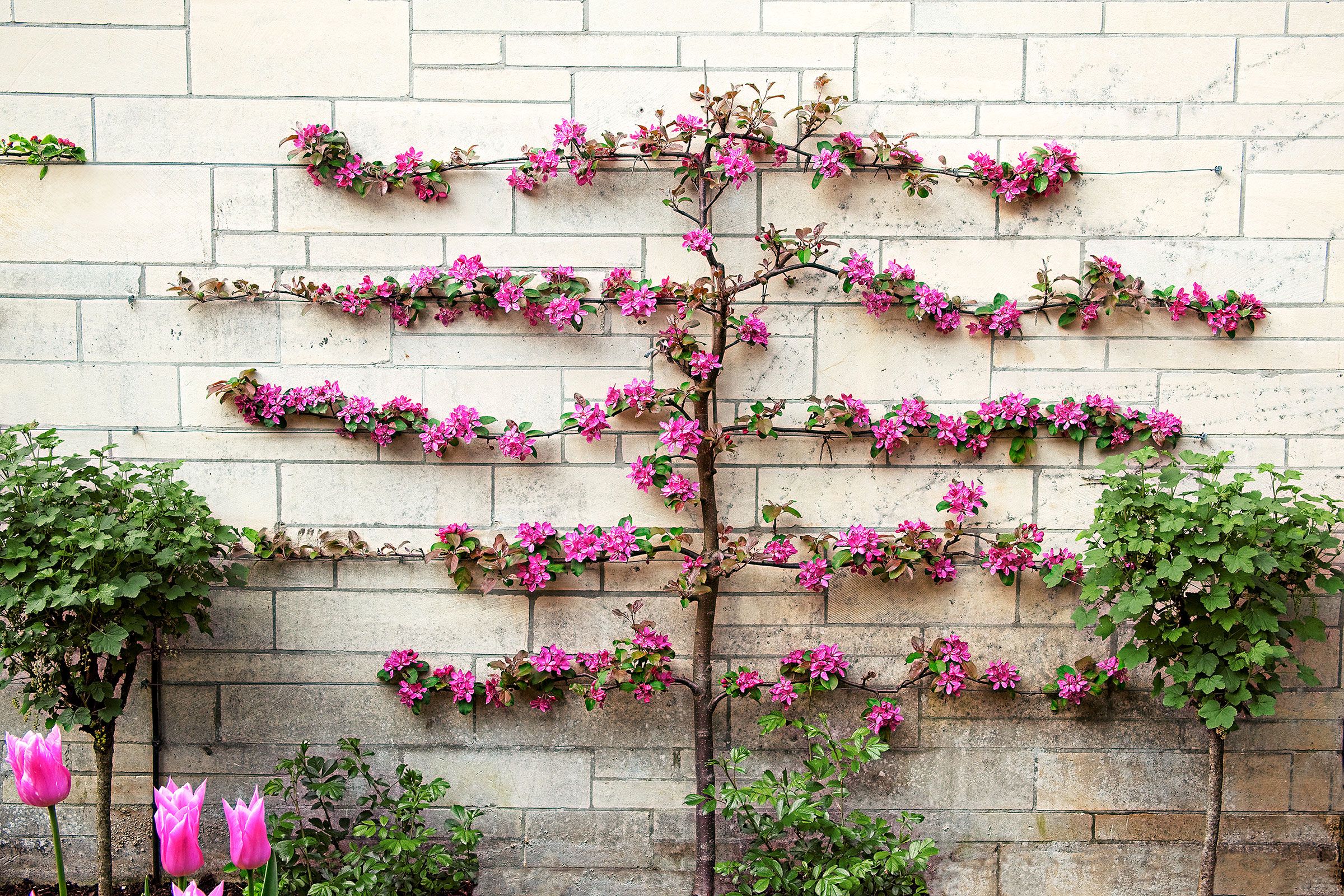Espalier, the art of training trees or shrubs to grow in two dimensions, is a clever solution for space-challenged gardens. This technique allows you to cultivate fruit trees in compact spaces, create living privacy screens, or transform plain walls into eye-catching focal points. Our guide covers methods and maintenance for growing espaliered trees so you can make the most of this unique garden feature.
How Espaliered Trees Got Their Start
Espalier, pronounced “ess-PAL-yer,” is derived from an Italian term for “support.” It’s a technique that involves training trees or shrubs to grow flat against a wall or fence, with branches spread horizontally. It’s an ideal solution for gardeners with limited space who still want to enjoy the beauty and bounty of fruit trees. Espalier allows you to grow apples, pears, and other fruits in areas where a full-sized tree wouldn’t fit, such as along a garage wall or as a divider between outdoor living spaces.
The practice of espalier dates back to medieval times when it allowed city dwellers to grow food within the safety of walled compounds. In America, it gained popularity during the colonial era, with notable figures such as George Washington incorporating espaliered pears and apples at his Mount Vernon estate.
Espalier Designs
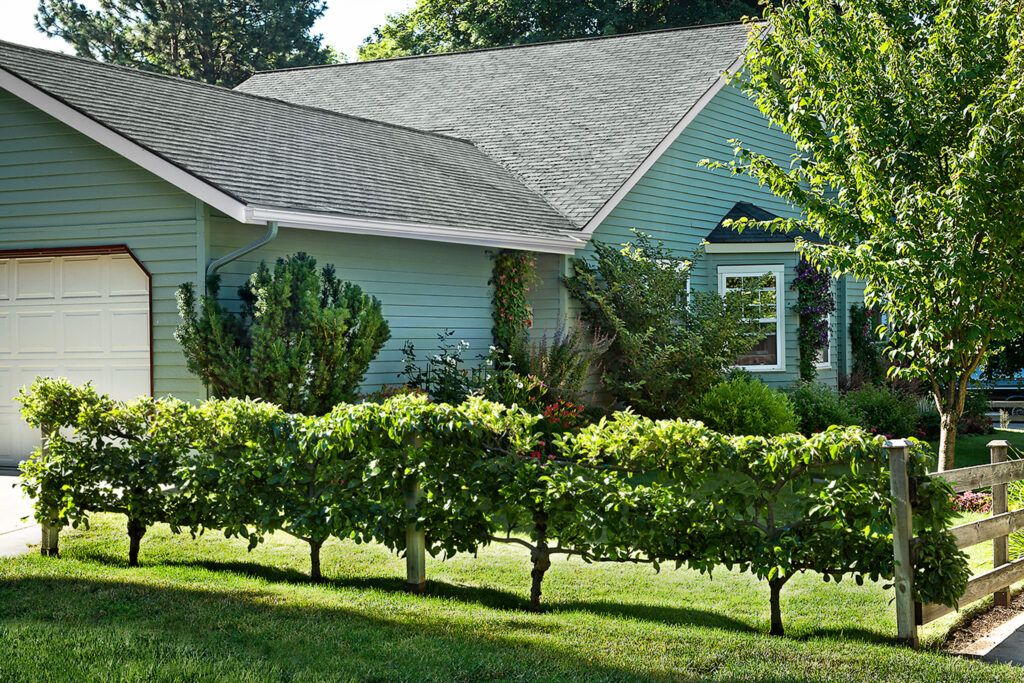
Espalier techniques often utilize walls to enhance growth and fruit production. The reflected heat from masonry surfaces can boost yields and accelerate ripening, making it particularly beneficial in borderline climate zones for fruit growing. However, espalier isn’t limited to wall-trained plants. It can also be used to create living fences or walls using sturdy poles and wires for support, which can be particularly advantageous in windy regions as the structure adds stability.
Common espalier patterns include the following:
- Horizontal cordon: Features evenly spaced branches spreading in lines from a central trunk
- Palmette verger: Resembles a candelabra with symmetrical, angled branches
- Belgian fence: Creates a leafy, crosshatched lattice pattern
Selecting the right espalier pattern can help divert and manage wind flow, potentially protecting other plants and creating microclimates suitable for varied species.
Espalier Tree Suggestions

The tree type and espalier method you choose depend on your goals, garden conditions, and willingness to invest time in pruning and training. Dwarf pear and apple trees are good candidates for formal espalier shapes, requiring at least six hours of daily sunlight. These fruit trees need careful pruning to preserve the fruit-bearing spurs, which are crucial for a consistent and healthy yield.
For shadier locations or more flexible, forgiving designs, consider ornamental plants with flexible branches, such as flowering camellias, pyracantha, or flowering quince.
These plants lend themselves to looser, free-form designs that are more forgiving of pruning mistakes. For the simplest espalier projects, vines such as ivy or wisteria can be trained to grow in specific patterns or directions. These varieties are particularly helpful in covering large areas quickly and adding to the garden’s overall vibrancy and appeal.
Best Trees for Esplaier Training
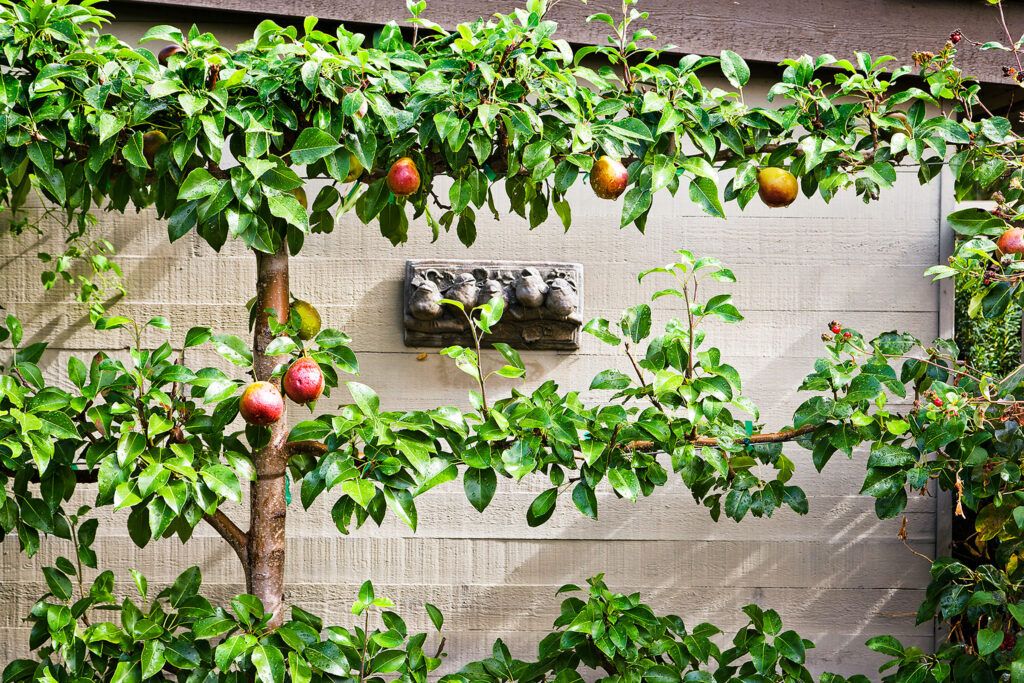
While training a tree from scratch can be challenging, many nurseries offer pre-trained espalier starts. These plants come already shaped and attached to trellising, making it easier to establish and maintain the form in your garden. When selecting trees for espalier, consider the following factors:
- Climate suitability: Choose varieties that are well-adapted to your local growing conditions.
- Space requirements: Opt for dwarf or semi-dwarf varieties for smaller areas.
- Pollination needs: Some fruit trees require a pollination partner for fruit production.
Pear and apple trees are popular choices for horizontal cordon espaliers, as this form places fruit within easy reach for harvesting. These trees exhibit vigorous growth habits that respond well to training, and their hardiness makes them ideal for diverse climate conditions.
Choosing a Plant Variety
For fruit trees in warmer regions, choose varieties with lower chilling requirements. When shopping for plants:
- Visit a reputable local nursery for expert advice.
- Look for robust, mostly unbranched 1-gallon plants called whips.
- Prioritize plants with malleable habits and seasonal interest.
Suitable ornamental choices include the following:
- Forsythia
- Jasmine
- Magnolia
- Photinia
Integrating a mix of evergreen and deciduous varieties promotes year-round interest, with spring blossoms, summer fruits, and autumn foliage keeping your garden dynamic and colorful. Bespoke plant selections can bring personalized charm and functionality to your garden space.
Choosing an Espalier Setup
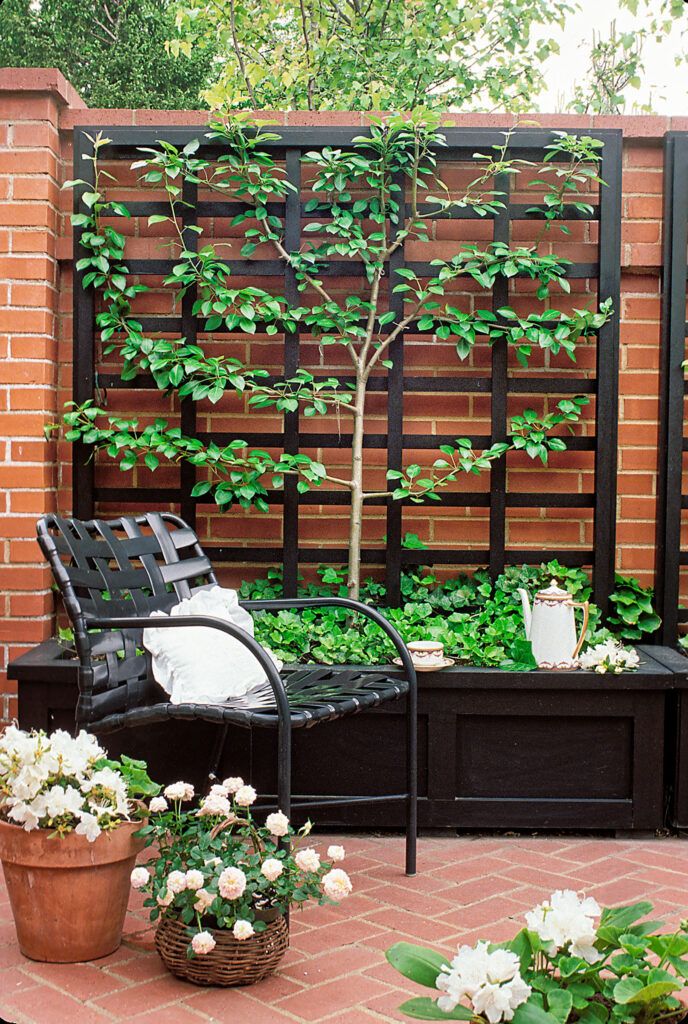
Before planting your espalier, create a scale drawing of your design. This plan will help you space the trees properly, guide your pruning decisions, and determine support structure needs.
For fruit trees, a south- or east-facing wall provides extra warmth for better ripening. When planning your support system, consider these options:
- Freestanding trellis
- Wire grid supported by eye bolts
- Wood lattice frame
For a beginner-friendly approach, try a planter box with an attached trellis. This setup allows you to easily tie branches to the support as they grow, using soft plant ties or jute twine to prevent damage to the bark. The modular nature of planter boxes also provides flexibility, as they can be re-positioned based on seasonal sunlight changes and growth requirements.
Determining soil amendments and seasonal garden layouts can also enhance the irrigation and general care of espaliered trees. Ensuring proper drainage, optimal soil mixes, and seasonal mulching are helpful in maintaining the health and vigor of your trees.
Planting Your Trees
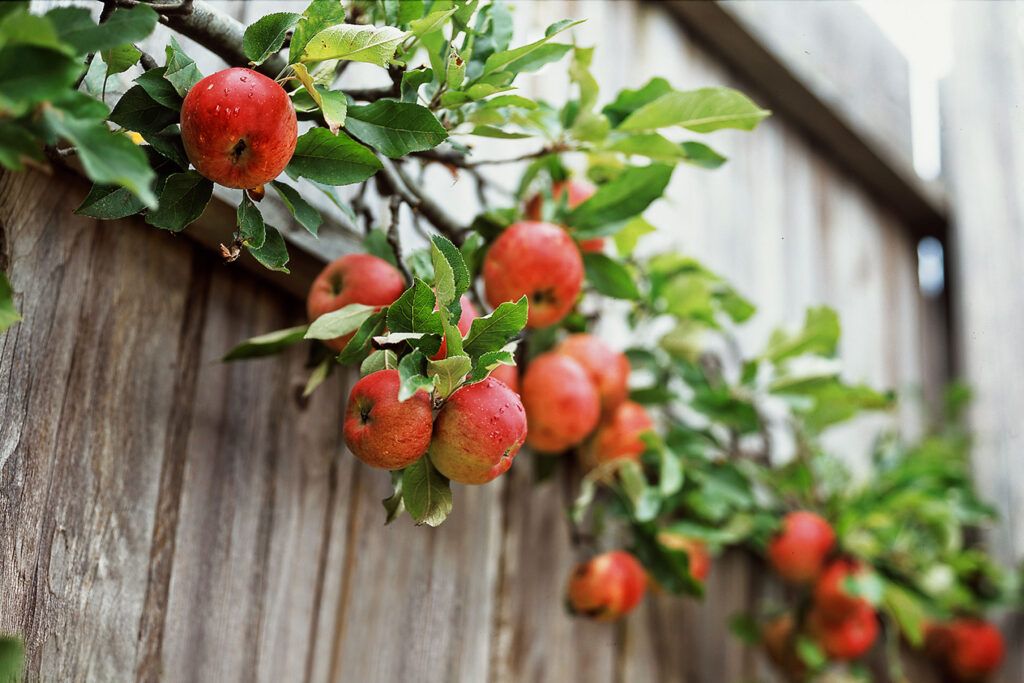
You can follow these steps when you’re ready to start planting:
- Dig planting holes about 6 inches from the wall to ensure proper air circulation.
- Amend the soil with organic compost.
- Plant at the same depth as in the container.
- Clip the tops to about 18 inches to encourage branching.
- As new growth appears, select the best side shoots and leader, removing the rest.
- When branches reach about a foot in length, tie them loosely to supports.
Prune annually in late winter or early spring before active growth begins. Continue to train branches as they develop, adjusting ties to accommodate growth. With patience and care, your espalier will develop into a stunning garden feature, adorned with flowers, foliage, or fruit that’s always within reach. Manage consistent watering schedules, ensuring the soil remains moist but not waterlogged, particularly in the early growing stages.
Incorporating creative garden lighting can also accentuate espaliered trees at night, turning them into magnificent focal points and extending the visual enjoyment of your garden into the evening hours.
How To Attach Supports to a Masonry Wall
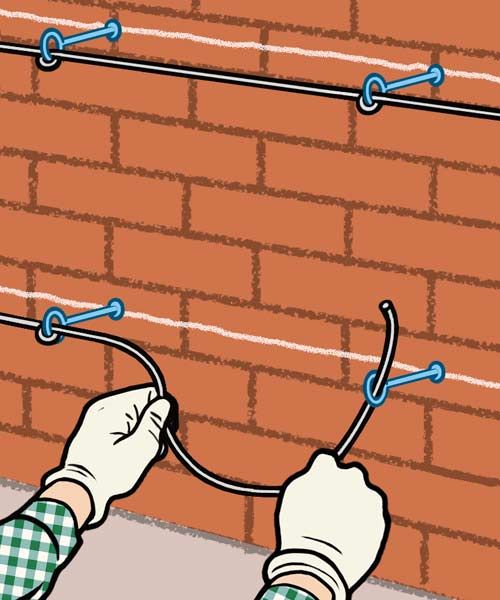
Creating a support system for espalier on a brick, block, or stone wall requires some preparation. Follow these steps to set up a sturdy framework:
- Use chalk to sketch your desired pattern directly on the wall.
- Drill holes along the pattern lines every 18 inches using a masonry bit.
- Insert 2-inch expansion shields into the cleaned-out holes.
- Screw in eyebolts long enough to create a 4- to 6-inch air space between the eyes and the wall.
- Secure 12- or 14-gauge wire between the eyebolts to create a trellis for tying branches.
This method provides a flexible, long-lasting support system that allows your espalier to thrive while maintaining proper air circulation between the plant and the wall. Additionally, the air gap created helps prevent moisture buildup and potential mold issues, furthering the health of your plants.
Using weather-resistant materials and periodically checking for wear and tear on the support structure can ensure that it remains sturdy and functional over the years. This extra care can provide longevity and sustained productivity for your espaliered installations.
Maintaining the Pattern
Plants grow from a central stem called the leader. By pruning the leader, you encourage side shoots to emerge from buds below the cut. Select the best two side shoots to form the main branches of your stylized tree, attaching them to wall hooks or wires. The topmost shoot becomes the new leader and eventually forms the trunk.
To maintain the desired shape:
- Prune away growth that deviates from your chosen pattern.
- Keep the plant low enough for easy maintenance.
- Regularly tie new growth to supports as it develops.
- Loosen old ties to prevent branches from girdling as they thicken.
With proper care, it typically takes three to four years to fully establish the shape of an espalier. After that, selective pruning maintains definition. Regularly inspecting the tree and adjusting the structure can also prevent potential issues such as overcrowding and disease spread.
Implementing a feeding schedule with organic compost or slow-release fertilizers can further sustain the health and productivity of your espaliered trees.
Espalier Maintenance Tips
Proper maintenance is key to keeping your espaliered trees healthy and attractive. Here are some tips:
- Regular pruning: Trim new growth 2–3 times during the growing season to maintain shape.
- Fertilization: Apply a balanced, slow-release fertilizer in early spring.
- Pest management: Monitor for common pests and diseases, treating them promptly if issues arise.
- Watering: Ensure consistent moisture, especially during fruit development for fruit-bearing espaliers.
- Winter protection: In colder climates, use a frost cloth to protect delicate branches.
Integrating complementary plants at the base can enhance aesthetics and provide additional benefits such as soil improvement or pest deterrence, contributing to a thriving, harmonious garden.
